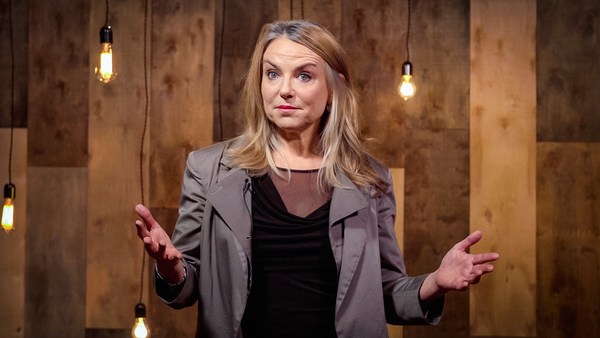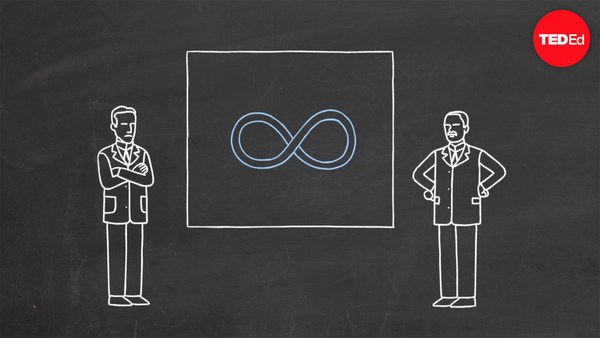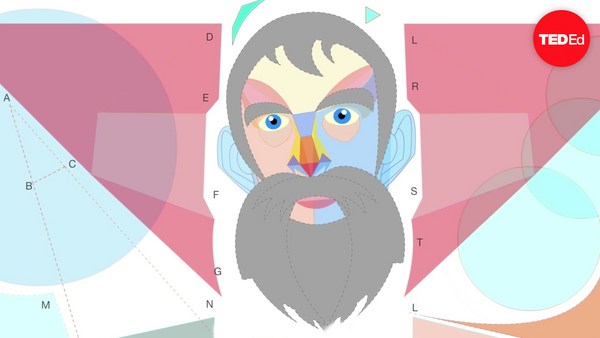Today I want to talk to you about the mathematics of love. Now, I think that we can all agree that mathematicians are famously excellent at finding love.
(Laughter)
But it's not just because of our dashing personalities, superior conversational skills and excellent pencil cases. It's also because we've actually done an awful lot of work into the maths of how to find the perfect partner.
Now, in my favorite paper on the subject, which is entitled, "Why I Don't Have a Girlfriend" --
(Laughter)
Peter Backus tries to rate his chances of finding love. Now, Peter's not a very greedy man. Of all of the available women in the UK, all Peter's looking for is somebody who lives near him, somebody in the right age range, somebody with a university degree, somebody he's likely to get on well with, somebody who's likely to be attractive, somebody who's likely to find him attractive.
(Laughter)
And comes up with an estimate of 26 women in the whole of the UK.
(Laughter)
It's not looking very good, is it Peter? Now, just to put that into perspective, that's about 400 times fewer than the best estimates of how many intelligent extraterrestrial life forms there are. And it also gives Peter a 1 in 285,000 chance of bumping into any one of these special ladies on a given night out. I'd like to think that's why mathematicians don't really bother going on nights out anymore.
The thing is that I personally don't subscribe to such a pessimistic view. Because I know, just as well as all of you do, that love doesn't really work like that. Human emotion isn't neatly ordered and rational and easily predictable. But I also know that that doesn't mean that mathematics hasn't got something that it can offer us, because, love, as with most of life, is full of patterns and mathematics is, ultimately, all about the study of patterns. Patterns from predicting the weather to the fluctuations in the stock market, to the movement of the planets or the growth of cities. And if we're being honest, none of those things are exactly neatly ordered and easily predictable, either. Because I believe that mathematics is so powerful that it has the potential to offer us a new way of looking at almost anything. Even something as mysterious as love. And so, to try to persuade you of how totally amazing, excellent and relevant mathematics is, I want to give you my top three mathematically verifiable tips for love.
(Laughter)
OK, so Top Tip #1: How to win at online dating. So my favorite online dating website is OkCupid, not least because it was started by a group of mathematicians. Now, because they're mathematicians, they have been collecting data on everybody who uses their site for almost a decade. And they've been trying to search for patterns in the way that we talk about ourselves and the way that we interact with each other on an online dating website. And they've come up with some seriously interesting findings. But my particular favorite is that it turns out that on an online dating website, how attractive you are does not dictate how popular you are, and actually, having people think that you're ugly can work to your advantage.
(Laughter)
Let me show you how this works. In a thankfully voluntary section of OkCupid, you are allowed to rate how attractive you think people are on a scale between one and five. Now, if we compare this score, the average score, to how many messages a selection of people receive, you can begin to get a sense of how attractiveness links to popularity on an online dating website.
This is the graph the OkCupid guys have come up with. And the important thing to notice is that it's not totally true that the more attractive you are, the more messages you get. But the question arises then of what is it about people up here who are so much more popular than people down here, even though they have the same score of attractiveness? And the reason why is that it's not just straightforward looks that are important. So let me try to illustrate their findings with an example. So if you take someone like Portia de Rossi, for example, everybody agrees that Portia de Rossi is a very beautiful woman. Nobody thinks that she's ugly, but she's not a supermodel, either. If you compare Portia de Rossi to someone like Sarah Jessica Parker, now, a lot of people, myself included, I should say, think that Sarah Jessica Parker is seriously fabulous and possibly one of the most beautiful creatures to have ever have walked on the face of the Earth. But some other people, i.e., most of the Internet ...
(Laughter)
seem to think that she looks a bit like a horse.
(Laughter)
Now, I think that if you ask people how attractive they thought Jessica Parker or Portia de Rossi were, and you ask them to give them a score between one and five I reckon that they'd average out to have roughly the same score. But the way that people would vote would be very different. So Portia's scores would all be clustered around the four because everybody agrees that she's very beautiful, whereas Sarah Jessica Parker completely divides opinion. There'd be a huge spread in her scores. And actually it's this spread that counts. It's this spread that makes you more popular on an online Internet dating website. So what that means then is that if some people think that you're attractive, you're actually better off having some other people think that you're a massive minger. That's much better than everybody just thinking that you're the cute girl next door.
Now, I think this begins to make a bit more sense when you think in terms of the people who are sending these messages. So let's say that you think somebody's attractive, but you suspect that other people won't necessarily be that interested. That means there's less competition for you and it's an extra incentive for you to get in touch. Whereas compare that to if you think somebody is attractive but you suspect that everybody is going to think they're attractive. Well, why would you bother humiliating yourself, let's be honest? But here's where the really interesting part comes. Because when people choose the pictures that they use on an online dating website, they often try to minimize the things that they think some people will find unattractive. The classic example is people who are, perhaps, a little bit overweight deliberately choosing a very cropped photo,
(Laughter)
or bald men, for example, deliberately choosing pictures where they're wearing hats. But actually this is the opposite of what you should do if you want to be successful. You should really, instead, play up to whatever it is that makes you different, even if you think that some people will find it unattractive. Because the people who fancy you are just going to fancy you anyway, and the unimportant losers who don't, well, they only play up to your advantage.
OK, Top Tip #2: How to pick the perfect partner. So let's imagine then that you're a roaring success on the dating scene. But the question arises of how do you then convert that success into longer-term happiness, and in particular, how do you decide when is the right time to settle down? Now generally, it's not advisable to just cash in and marry the first person who comes along and shows you any interest at all. But, equally, you don't really want to leave it too long if you want to maximize your chance of long-term happiness. As my favorite author, Jane Austen, puts it, "An unmarried woman of seven and twenty can never hope to feel or inspire affection again."
(Laughter)
Thanks a lot, Jane. What do you know about love?
(Laughter)
So the question is then, how do you know when is the right time to settle down, given all the people that you can date in your lifetime? Thankfully, there's a rather delicious bit of mathematics that we can use to help us out here, called optimal stopping theory. So let's imagine, then, that you start dating when you're 15 and ideally, you'd like to be married by the time that you're 35. And there's a number of people that you could potentially date across your lifetime, and they'll be at varying levels of goodness. Now the rules are that once you cash in and get married, you can't look ahead to see what you could have had, and equally, you can't go back and change your mind. In my experience at least, I find that typically people don't much like being recalled years after being passed up for somebody else, or that's just me.
So the math says then that what you should do in the first 37 percent of your dating window, you should just reject everybody as serious marriage potential.
(Laughter)
And then, you should pick the next person that comes along that is better than everybody that you've seen before. So here's the example. Now if you do this, it can be mathematically proven, in fact, that this is the best possible way of maximizing your chances of finding the perfect partner. Now unfortunately, I have to tell you that this method does come with some risks. For instance, imagine if your perfect partner appeared during your first 37 percent. Now, unfortunately, you'd have to reject them.
(Laughter)
Now, if you're following the maths, I'm afraid no one else comes along that's better than anyone you've seen before, so you have to go on rejecting everyone and die alone.
(Laughter)
Probably surrounded by cats ...
(Laughter)
nibbling at your remains.
OK, another risk is, let's imagine, instead, that the first people that you dated in your first 37 percent are just incredibly dull, boring, terrible people. That's OK, because you're in your rejection phase, so that's fine, you can reject them. But then imagine the next person to come along is just marginally less boring, dull and terrible ...
(Laughter)
than everybody that you've seen before. Now, if you are following the maths, I'm afraid you have to marry them ...
(Laughter)
and end up in a relationship which is, frankly, suboptimal. Sorry about that. But I do think that there's an opportunity here for Hallmark to cash in on and really cater for this market. A Valentine's Day card like this.
(Laughter)
"My darling husband, you are marginally less terrible than the first 37 percent of people I dated."
(Laughter)
It's actually more romantic than I normally manage.
(Laughter)
OK, so this method doesn't give you a 100 percent success rate, but there's no other possible strategy that can do any better. And actually, in the wild, there are certain types of fish which follow and employ this exact strategy. So they reject every possible suitor that turns up in the first 37 percent of the mating season, and then they pick the next fish that comes along after that window that's, I don't know, bigger and burlier than all of the fish that they've seen before. I also think that subconsciously, humans, we do sort of do this anyway. We give ourselves a little bit of time to play the field, get a feel for the marketplace or whatever when we're young. And then we only start looking seriously at potential marriage candidates once we hit our mid-to-late 20s. I think this is conclusive proof, if ever it were needed, that everybody's brains are prewired to be just a little bit mathematical.
OK, so that was Top Tip #2. Now, Top Tip #3: How to avoid divorce. OK, so let's imagine then that you picked your perfect partner and you're settling into a lifelong relationship with them. Now, I like to think that everybody would ideally like to avoid divorce, apart from, I don't know, Piers Morgan's wife, maybe?
(Laughter)
But it's a sad fact of modern life that one in two marriages in the States ends in divorce, with the rest of the world not being far behind. Now, you can be forgiven, perhaps for thinking that the arguments that precede a marital breakup are not an ideal candidate for mathematical investigation. For one thing, it's very hard to know what you should be measuring or what you should be quantifying. But this didn't stop a psychologist, John Gottman, who did exactly that. Gottman observed hundreds of couples having a conversation and recorded, well, everything you can think of. So he recorded what was said in the conversation, he recorded their skin conductivity, he recorded their facial expressions, their heart rates, their blood pressure, basically everything apart from whether or not the wife was actually always right, which incidentally she totally is. But what Gottman and his team found was that one of the most important predictors for whether or not a couple is going to get divorced was how positive or negative each partner was being in the conversation.
Now, couples that were very low-risk scored a lot more positive points on Gottman's scale than negative. Whereas bad relationships, by which I mean, probably going to get divorced, they found themselves getting into a spiral of negativity. Now just by using these very simple ideas, Gottman and his group were able to predict whether a given couple was going to get divorced with a 90 percent accuracy. But it wasn't until he teamed up with a mathematician, James Murray, that they really started to understand what causes these negativity spirals and how they occur. And the results that they found, I think, are just incredibly impressively simple and interesting. So these equations predict how the wife or husband is going to respond in their next turn of the conversation, how positive or negative they're going to be. And these equations depend on the mood of the person when they're on their own, the mood of the person when they're with their partner, but most importantly, they depend on how much the husband and wife influence one another.
Now, I think it's important to point out at this stage, that these exact equations have also been shown to be perfectly able at describing what happens between two countries in an arms race.
(Laughter)
So that an arguing couple spiraling into negativity and teetering on the brink of divorce is actually mathematically equivalent to the beginning of a nuclear war.
(Laughter)
But the really important term in this equation is the influence that people have on one another, and in particular, something called "the negativity threshold." Now, the negativity threshold, you can think of as how annoying the husband can be before the wife starts to get really pissed off, and vice versa. Now, I always thought that good marriages were about compromise and understanding and allowing the person to have the space to be themselves. So I would have thought that perhaps the most successful relationships were ones where there was a really high negativity threshold. Where couples let things go and only brought things up if they really were a big deal. But actually, the mathematics and subsequent findings by the team have shown the exact opposite is true. The best couples, or the most successful couples, are the ones with a really low negativity threshold. These are the couples that don't let anything go unnoticed and allow each other some room to complain. These are the couples that are continually trying to repair their own relationship, that have a much more positive outlook on their marriage. Couples that don't let things go and couples that don't let trivial things end up being a really big deal.
Now of course, it takes a bit more than just a low negativity threshold and not compromising to have a successful relationship. But I think that it's quite interesting to know that there is really mathematical evidence to say that you should never let the sun go down on your anger.
So those are my top three tips of how maths can help you with love and relationships. But I hope, that aside from their use as tips, they also give you a little bit of insight into the power of mathematics. Because for me, equations and symbols aren't just a thing. They're a voice that speaks out about the incredible richness of nature and the startling simplicity in the patterns that twist and turn and warp and evolve all around us, from how the world works to how we behave. So I hope that perhaps, for just a couple of you, a little bit of insight into the mathematics of love can persuade you to have a little bit more love for mathematics.
Thank you.
(Applause)





